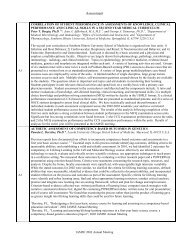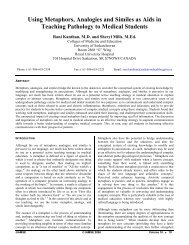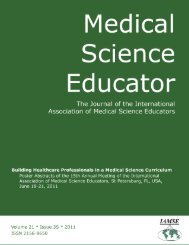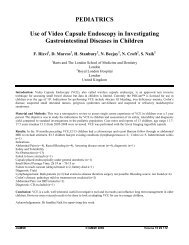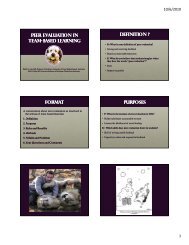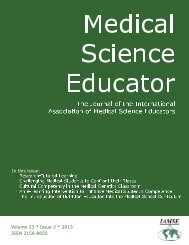Click here to view complete journal in pdf-format - IAMSE
Click here to view complete journal in pdf-format - IAMSE
Click here to view complete journal in pdf-format - IAMSE
Create successful ePaper yourself
Turn your PDF publications into a flip-book with our unique Google optimized e-Paper software.
CONCLUSIONS<br />
Program evaluations showed that this was a<br />
successful pilot although it <strong>in</strong>cluded only 2<br />
professional programs (BS/MD and PA). Initially<br />
t<strong>here</strong> were some concerns that medical and PA<br />
students were not optimally matched <strong>in</strong> terms of<br />
cl<strong>in</strong>ical experience. Consistent faculty report<br />
revealed that while the PA students were cl<strong>in</strong>ically<br />
more advanced, the BS/MD students had<br />
significantly more communication skills tra<strong>in</strong><strong>in</strong>g<br />
and thus performed much better with relationship<br />
build<strong>in</strong>g, <strong>in</strong>ter<strong>view</strong><strong>in</strong>g and counsel<strong>in</strong>g tasks. IPE can<br />
be beneficial even if circumstances appear less than<br />
optimal.<br />
Curriculum Abstract ID: 146 Award Nom<strong>in</strong>ee<br />
STRUCTURE: AN INTERDISCIPLINARY<br />
COURSE IN HUMAN FORM<br />
Keith Metzger, David Elkowitz and William<br />
Rennie, Hofstra North Shore-LIJ School of<br />
Medic<strong>in</strong>e, Hempstead, NY, USA<br />
PURPOSE<br />
Structure, a 2-year course <strong>in</strong> human form,<br />
comprises part of the <strong>in</strong>tegrated UME curriculum at<br />
the Hofstra North Shore-LIJ School of Medic<strong>in</strong>e.<br />
Traditionally, content related <strong>to</strong> human structure is<br />
fragmented across the undergraduate medical<br />
curriculum, divid<strong>in</strong>g study of form <strong>in</strong><strong>to</strong> separate<br />
courses on normal macroscopic (ana<strong>to</strong>my),<br />
microscopic (his<strong>to</strong>logy), abnormal (pathology and<br />
his<strong>to</strong>pathology), developmental (embryology), and<br />
cl<strong>in</strong>ical (medical imag<strong>in</strong>g) <strong>to</strong>pics. Our course<br />
(“Structure”) br<strong>in</strong>gs these <strong>to</strong>pics <strong>to</strong>gether, allow<strong>in</strong>g<br />
students <strong>to</strong> explore human form <strong>in</strong> an <strong>in</strong>tegrated<br />
context.<br />
METHODS<br />
Labora<strong>to</strong>ry sessions feature active small group<br />
learn<strong>in</strong>g with content expert facilita<strong>to</strong>rs. Small<br />
group sessions <strong>in</strong>volve Socratic question<strong>in</strong>g by<br />
faculty and progression from recall of knowledge <strong>to</strong><br />
its application. Ana<strong>to</strong>mical dissection is conducted<br />
through focused “problem-based dissections” that<br />
revolve around cl<strong>in</strong>ical cases and require students <strong>to</strong><br />
<strong>in</strong>tegrate structural <strong>to</strong>pics. Physical exam<br />
<strong>in</strong>struction and use of ultrasound have also been<br />
<strong>in</strong>tegrated <strong>in</strong><strong>to</strong> the course curriculum. This course<br />
was developed by assembl<strong>in</strong>g an <strong>in</strong>terdiscipl<strong>in</strong>ary<br />
team that developed learn<strong>in</strong>g objectives, weekly<br />
labora<strong>to</strong>ry sessions and assessments that were<br />
aligned with <strong>in</strong>stitutional educational program<br />
objectives.<br />
RESULTS<br />
This curriculum was implemented <strong>in</strong> the Fall of<br />
2011 with our <strong>in</strong>augural class. Student re<strong>view</strong>s of<br />
this course have been very positive and educational<br />
research projects are underway <strong>to</strong> assess the efficacy<br />
of this program <strong>in</strong> <strong>in</strong>creas<strong>in</strong>g retention and<br />
application of cl<strong>in</strong>ically oriented <strong>to</strong>pics <strong>in</strong> human<br />
form.<br />
CONCLUSIONS<br />
As UME curricula cont<strong>in</strong>ue transition<strong>in</strong>g <strong>to</strong> an<br />
<strong>in</strong>tegrated model, traditionally separate <strong>to</strong>pics <strong>in</strong><br />
human structure may also require significant<br />
modification. We believe that our model for such<br />
<strong>in</strong>tegration holds great potential for l<strong>in</strong>k<strong>in</strong>g <strong>to</strong>gether<br />
basic and cl<strong>in</strong>ical sciences <strong>in</strong> a relevant context.<br />
Curriculum Abstract ID: 147<br />
A LABORATORY FOR EDUCATION IN<br />
MOLECULAR MEDICINE: A DEDICATED<br />
RESOURCE FOR MEDICAL STUDENT<br />
RESEARCH<br />
Curt M. Pfarr, Amy Trott, Debra Bramblett, Tanis<br />
Hogg, David Osbourne, Rosal<strong>in</strong> Cooper, Heather<br />
Balsiger & Mart<strong>in</strong>e Coue Paul L. Foster School of<br />
Medic<strong>in</strong>e, El Paso, TX, USA<br />
PURPOSE<br />
Achiev<strong>in</strong>g mean<strong>in</strong>gful results <strong>in</strong> research projects is<br />
a serious challenge <strong>to</strong> undergraduate medical<br />
students. Several constra<strong>in</strong>ts, primarily time, limit<br />
the depth and progress of student projects; often<br />
these constra<strong>in</strong>ts dictate that the student's efforts be<br />
only a small part of a larger project directed by more<br />
dedicated research personnel. To provide a deeper<br />
research experience we have developed a unique<br />
labora<strong>to</strong>ry resource at the new Paul L. Foster School<br />
of Medic<strong>in</strong>e that allows our students <strong>to</strong> pursue<br />
men<strong>to</strong>red research projects <strong>in</strong> basic and<br />
translational projects.<br />
METHODS<br />
This Labora<strong>to</strong>ry for Education <strong>in</strong> Molecular<br />
Medic<strong>in</strong>e (LEMM) is a fully equipped molecular<br />
biology BSL-2 lab that is outfitted with state-of-theart<br />
<strong>in</strong>strumentation that is essential for a wide<br />
variety of cellular and molecular biology techniques.<br />
This <strong>in</strong>strumentation facilitates the level, scale, and<br />
accuracy necessary for the student research<br />
projects. These equipment and <strong>in</strong>strumentation<br />
items have been carefully selected <strong>to</strong> form an<br />
<strong>in</strong>tegrated core ensemble that allows the entire<br />
standard reper<strong>to</strong>ire of modern molecular medic<strong>in</strong>e<br />
techniques and methodologies <strong>to</strong> be performed. In<br />
particular, the labora<strong>to</strong>ry is 100% radioactivity-free,<br />
rely<strong>in</strong>g exclusively on light-based techniques for<br />
Medical Science Educa<strong>to</strong>r © <strong>IAMSE</strong> 2012 Volume 22(4S) 293



